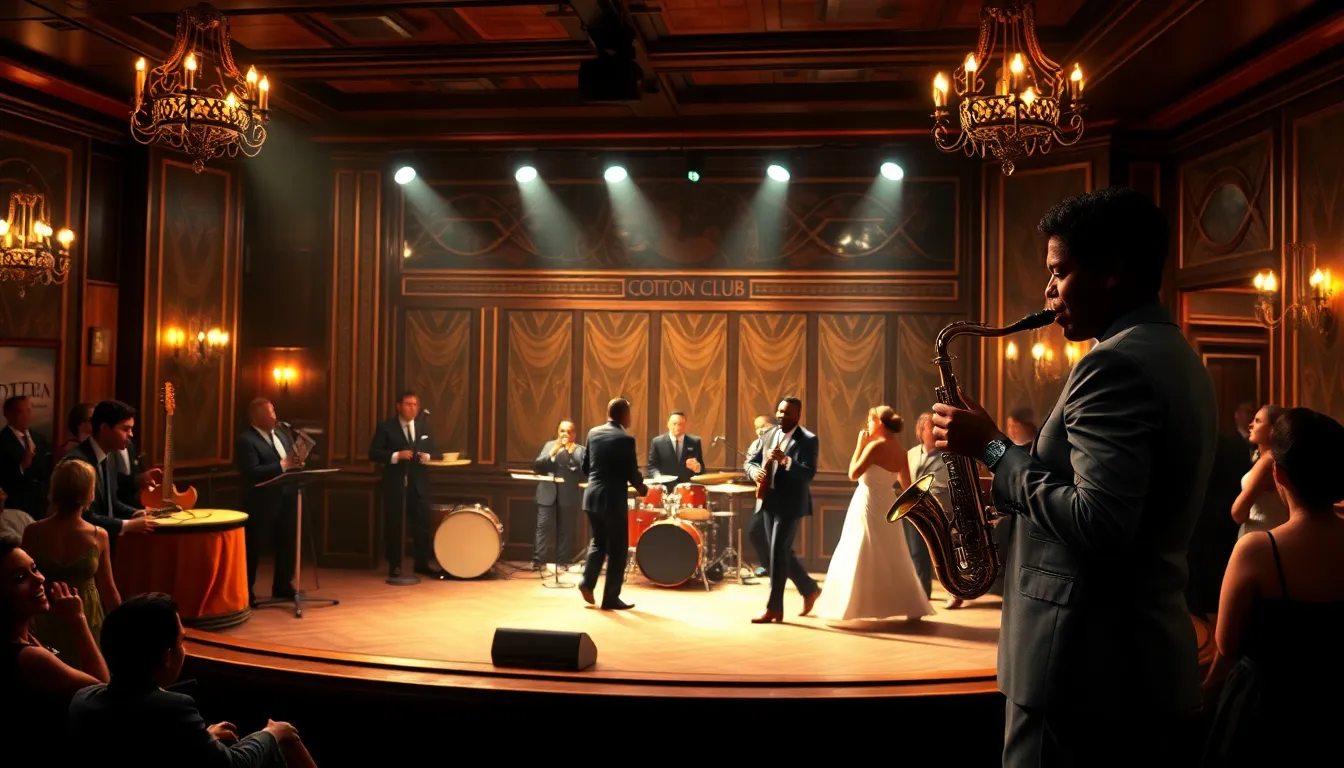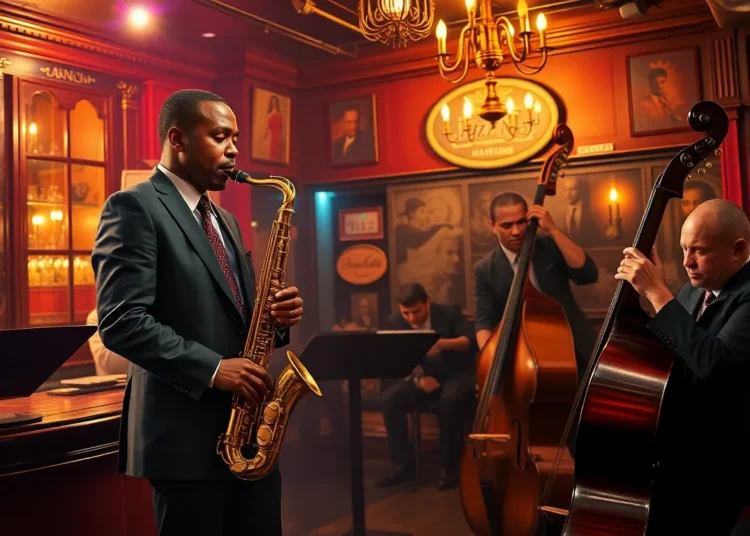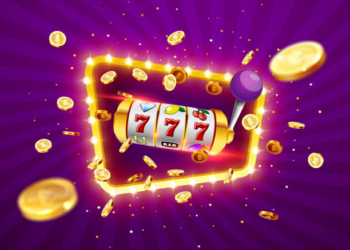Harlem jazz music isn’t just a genre; it’s a vibrant heartbeat that echoes through the streets of New York City. Picture this: a smoky club, the sweet sound of a saxophone weaving through the air, and the rhythm of a double bass that makes even the most serious folks tap their feet. It’s a scene that’s as rich as the history behind it, filled with legends who turned improvisation into an art form.
Harlem Jazz Music
Harlem jazz music emerged in the early 20th century, rooted in African American culture. Its development occurred against a backdrop of significant social change and cultural expression.
Historical Context
The Harlem Renaissance played a crucial role in shaping jazz music. This cultural movement in the 1920s and 1930s showcased African American artistic achievements. Figures like Duke Ellington and Louis Armstrong rose to prominence during this period, transforming music scenes across the country. Jazz clubs in Harlem became vibrant meeting places, fostering creativity and collaboration. These establishments allowed musicians to explore new sounds and styles, paving the way for future generations.
Key Influences
Several factors contributed to the evolution of Harlem jazz music. The Great Migration brought numerous African Americans to Northern cities, infusing new energy into urban life. Traditional African rhythms and blues provided a foundation for jazz, while gospel music inspired emotional depth. Instruments like the trumpet and piano became the backbone of orchestras, enhancing the genre’s richness. Additionally, the influence of European musical structures added complexity to the improvisational style. These various elements coalesced, creating a distinct sound that resonated within Harlem’s artistic community.
Iconic Harlem Jazz Venues

Harlem showcases several iconic jazz venues that have played pivotal roles in the music’s history and evolution. These locations continue to celebrate the vibrant energy of jazz music.
The Cotton Club
The Cotton Club stands as a historical landmark, nestled in the heart of Harlem. Founded in 1923, it served as a premier venue for African American musicians during the jazz age. Notable artists like Duke Ellington and Ella Fitzgerald graced its stage, captivating audiences with their talent. The club’s unique blend of jazz, dining, and nightlife attracted a diverse crowd, transcending racial barriers. Live performances featured some of the best talents of the time, creating an unforgettable atmosphere. Its legacy remains significant, symbolizing the flourishing jazz scene and its impact on American music.
Apollo Theater
The Apollo Theater, another iconic venue, has a rich history within the Harlem jazz community. Established in 1934, it became renowned for its amateur nights, providing a platform for emerging artists. The theater helped launch the careers of legendary figures like Billie Holiday and James Brown. Spectacular performances and vibrant energy characterized the venue, drawing large audiences well into the night. Its iconic status extends beyond jazz, reflecting the broader influence of African American culture in entertainment. Today, the Apollo continues to host various music genres, celebrating the enduring legacy of jazz within its walls.
Harlem Jazz Musicians
Harlem jazz music boasts a lineup of legendary musicians who shaped the genre and the cultural landscape of the area.
Duke Ellington
Duke Ellington stands out as one of the most influential figures in jazz history. Born in Washington, D.C., he moved to Harlem and quickly became a central figure in the jazz scene. His innovative compositions, such as “Mood Indigo” and “Take the ‘A’ Train,” exhibited his mastery of blending harmonies and rhythms. Ellington led a renowned orchestra that performed regularly at the Cotton Club, helping to popularize jazz across racial divides. His sophisticated style set a benchmark for future musicians and emphasized the importance of big band arrangements in the Harlem jazz movement. Today, his legacy remains evident through his extensive catalog of musical works and ongoing influence on jazz artists.
Billie Holiday
Billie Holiday, known for her emotive vocal style, transformed jazz music through her unique approach. Born in Philadelphia, she gained fame during the Harlem Renaissance, singing in clubs like the Apollo Theater. Holiday’s ability to convey deep emotion through her music resonated with audiences, making her hits like “God Bless the Child” and “Strange Fruit” timeless classics. Her collaborations with other prominent musicians, including Lester Young and Count Basie, showcased her versatility and artistry. Despite facing personal struggles, her talent captivated many and inspired countless artists across genres. Holiday’s contributions significantly shaped the development of jazz in Harlem and beyond.
The Evolution of Harlem Jazz Music
Harlem jazz music experienced multiple transformative phases over the decades, reflecting the changing cultural landscape.
The Swing Era
The Swing Era, spanning the 1930s and 1940s, marked a dynamic period in jazz history. It showcased big band compositions that captivated audiences in Harlem and beyond. Artists like Duke Ellington and Count Basie led orchestras that brought rhythm and energy to performances. Dance halls and clubs thrived as patrons flocked to experience the lively music. The influence of swing extended into popular culture, establishing jazz as a mainstream genre. This era emphasized improvisation while maintaining strong melodies, allowing musicians to explore their creativity within structured arrangements.
Modern Interpretations
Modern interpretations of Harlem jazz reflect an evolution while honoring its rich heritage. Contemporary artists blend traditional elements with genres like hip-hop and R&B, creating a fusion that resonates with new audiences. Musicians such as Kamasi Washington and Esperanza Spalding honor jazz’s improvisational roots while incorporating modern sounds and narratives. These artists often perform in historic venues, connecting with the legacy of Harlem jazz. Festivals celebrating both the past and present showcase the genre’s adaptability, ensuring its relevance in today’s music scene. Such innovation allows Harlem jazz to thrive, inspiring future generations of musicians and fans alike.
The Cultural Impact of Harlem Jazz Music
Harlem jazz music boasts a significant cultural impact, influencing literature and social movements alike.
Literary Connections
Literary figures often draw inspiration from Harlem jazz. Writers such as Langston Hughes and Zora Neale Hurston infused their works with the rhythms and themes found in jazz music. Poetry often mirrors the improvisational elements of jazz, reflecting the emotional depth of the genre. Jazz clubs served as backdrops for storytelling, capturing the vibrancy and struggles of African American life. Authors utilized jazz as a symbol of freedom and creativity, exploring complex themes through their narratives. The interplay between jazz and literature helped solidify Harlem as a center for artistic expression.
Social Movements
Social movements prominently featured jazz as a form of protest and expression. The Harlem Renaissance emerged as an artistic uprising, highlighting racial pride and cultural identity. Musicians like Billie Holiday used their platforms to address social injustices, with songs such as “Strange Fruit” challenging systemic racism. Jazz became a tool for solidarity during the Civil Rights Movement, rallying voices and unifying people. Events like the Jazz for Justice concert series aimed to raise awareness about inequality. As a result, Harlem jazz music remains intertwined with social activism, inspiring change through its powerful voice.
Conclusion
Harlem jazz music stands as a testament to the rich cultural tapestry of New York City. Its vibrant history and dynamic evolution continue to inspire musicians and audiences alike. The genre’s roots in the African American experience reflect a powerful narrative of creativity and resilience.
As contemporary artists breathe new life into traditional sounds, the legacy of Harlem jazz remains strong. Festivals and performances celebrate this unique art form, ensuring its place in the musical landscape. With each note played and every story shared, Harlem jazz music will undoubtedly continue to resonate for generations to come.










